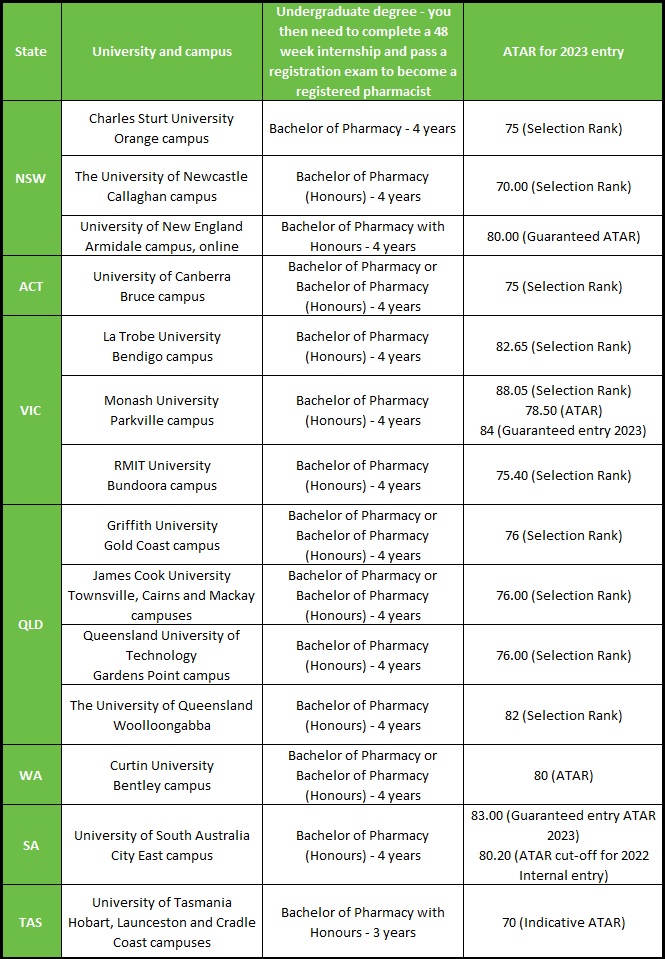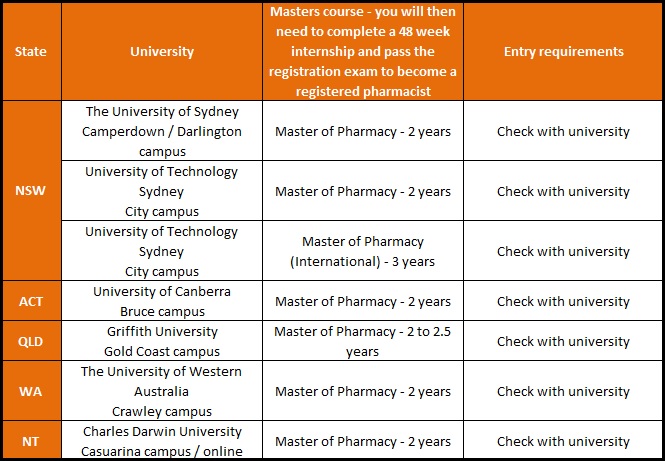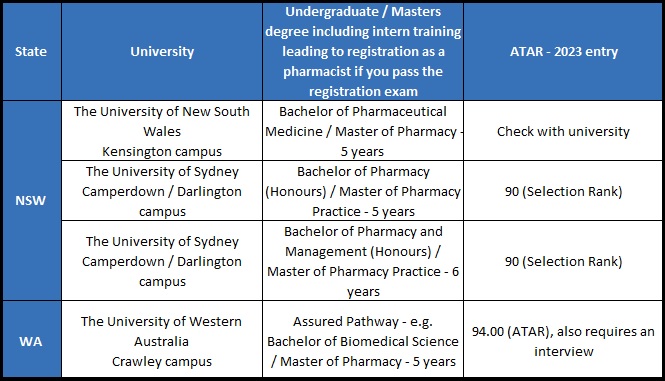ATAR for Pharmacy – every course in Australia
There are schools of pharmacy in every state and territory in Australia. Depending on whether which pathway you take, it takes a minimum of 5 to 6 years to become a pharmacist, and the pathway includes university study, supervised practice (internship), and a written & oral registration examination.
Undergraduate entry – ATAR for pharmacy
For entry into undergraduate pharmacy courses in 2023, the ATAR/Selection Rank was in the 70s or 80s. Following is a guide for the ATAR scores or Selection Ranks for every pharmacy course in Australia in 2023:
 Please note that apart from your ATAR, entry and/or placement requirements for undergraduate pharmacy may also include:
Please note that apart from your ATAR, entry and/or placement requirements for undergraduate pharmacy may also include:
- a police check
- a working with children check
- pre-requisite subjects
- first aid training
- health checks and immunisations
It is also worth noting that some universities will accept applicants who hold a full or partial Bachelor’s degree. Some universities also have specific entry requirements for students from a rural or Aboriginal and Torres Strait Islander background. Please check with the universities you are looking at applying to for their complete entry requirements as this varies widely across the different universities.
After completing a Bachelor’s degree in pharmacy, you are required to complete a 1-year intern training program and pass a registration examination to become a registered pharmacist.
Bachelor/Masters degree in pharmacy
Some universities are offering an undergraduate degree with a masters degree in pharmacy. Check with each university regarding these courses, as some incorporate the internship, while others require internship completion following course completion. In any case, you will still be required to pass the registration examination to become a registered pharmacist.
Graduate entry into pharmacy
Entry into postgraduate pharmacy courses will involve requirements such as a high Grade Point Average (GPA) in your undergraduate degree as well as pre-requisite subjects.
Following is a table which shows postgraduate qualifications which lead to registration as a pharmacist in Australia (following internship and registration examination):
 Please note that apart from your GPA and pre-requisite subjects, graduate entry and/or placement requirements for pharmacy may also include:
Please note that apart from your GPA and pre-requisite subjects, graduate entry and/or placement requirements for pharmacy may also include:
- a police check
- a working with children check
- first aid training
- health checks and immunisations
After completing one of the above Masters degree in pharmacy, you are required to complete a 1-year intern training program and pass the registration examination to become a registered pharmacist.
Current list of approved programs of study to become a pharmacist
The information presented in this article was correct at the time of publishing. Please check with the Australian Health Practitioner Regulation Agency for an up to date list of approved programs of study on the pathway to becoming a pharmacist in Australia.
If you would like to find courses to become a pharmacist:
1. Go to https://www.ahpra.gov.au/Accreditation/Approved-Programs-of-Study.aspx
2. In Profession select Pharmacist
3. In Country make the appropriate selection – for example, Australia
4. In Qualification Type select General
5. Click Search
More resources on My Health Career
- Your free guide to a career in pharmacy
- Videos about a career in pharmacy
- Two pharmacists on what they love about their job
Disclaimer
This information is general in nature and does not take into account your personal circumstances. My Health Career accepts no responsibility for ensuring that you enrol in a course that is right for you. Please do your own research to ensure that you enrol in the correct course. This may include speaking with people in the profession, a careers advisor, guidance officer, career development practitioner, representatives of the Pharmaceutical Society of Australia, and admissions officers from the university or universities you are looking at applying to.

